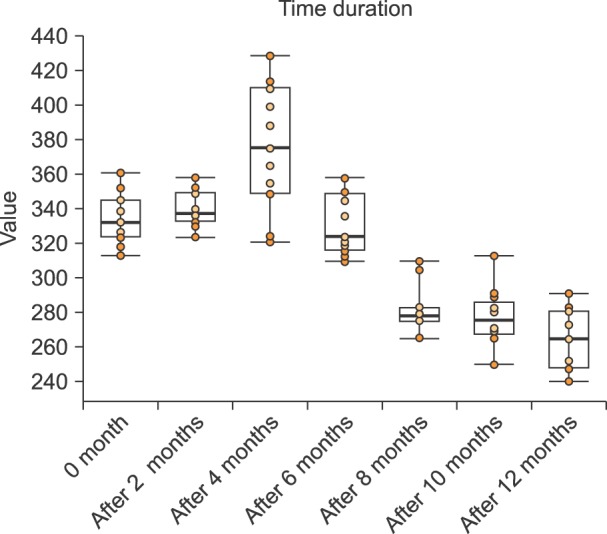Blood Res.
2015 Jun;50(2):109-112. 10.5045/br.2015.50.2.109.
Stability of eosin-5'-maleimide dye used in flow cytometric analysis for red cell membrane disorders
- Affiliations
-
- 1Department of Pathology, Medanta, The Medicity, Gurgaon, India. mehrasimmi80@gmail.com
- KMID: 2172775
- DOI: http://doi.org/10.5045/br.2015.50.2.109
Abstract
- BACKGROUND
The eosin-5'-maleimide (EMA) binding test using flow cytometry is a common method to measure reduced mean channel fluorescence (MCF) of EMA-labeled red blood cells (RBCs) from patients with red cell membrane disorders. The basic principle of the EMA-RBC binding test involves the covalent binding of EMA to lysine-430 on the first extracellular loop of band 3 protein.
METHODS
In the present study, the MCF of EMA was analyzed for samples derived from 12 healthy volunteers (controls) to determine the stability (i.e., the percentage decrease in fluorescence) of EMA over a period of 1 year.
RESULTS
Comparison of periodical MCF readings over time, that is, at 2-month intervals, showed that there were no significant changes in mean channel fluorescence for up to 6 months; however, there was a significant decrease in MCF at 8 months.
CONCLUSION
For optimal dye utilization, EMA remained stable only for up to 6 months. Therefore, we recommend reconstitution of the dye every 6 months when implementing this test and storage at -80degrees C in dark conditions.
MeSH Terms
Figure
Reference
-
1. Hunt L, Greenwood D, Heimpel H, Noel N, Whiteway A, King MJ. Toward the harmonization of result presentation for the eosin-5'-maleimide binding test in the diagnosis of hereditary spherocytosis. Cytometry B Clin Cytom. 2015; 88:50–57. PMID: 25227211.
Article2. King MJ, Telfer P, MacKinnon H, et al. Using the eosin-5-maleimide binding test in the differential diagnosis of hereditary spherocytosis and hereditary pyropoikilocytosis. Cytometry B Clin Cytom. 2008; 74:244–250. PMID: 18454487.
Article3. Bolton-Maggs PH, Stevens RF, Dodd NJ, et al. Guidelines for the diagnosis and management of hereditary spherocytosis. Br J Haematol. 2004; 126:455–474. PMID: 15287938.
Article4. An X, Mohandas N. Disorders of red cell membrane. Br J Haematol. 2008; 141:367–375. PMID: 18341630.
Article5. Bianchi P, Fermo E, Vercellati C, et al. Diagnostic power of laboratory tests for hereditary spherocytosis: a comparison study in 150 patients grouped according to molecular and clinical characteristics. Haematologica. 2012; 97:516–523. PMID: 22058213.
Article6. King MJ, Behrens J, Rogers C, Flynn C, Greenwood D, Chambers K. Rapid flow cytometric test for the diagnosis of membrane cytoskeleton-associated haemolytic anaemia. Br J Haematol. 2000; 111:924–933. PMID: 11122157.
Article7. Kedar PS, Colah RB, Kulkarni S, Ghosh K, Mohanty D. Experience with eosin-5'-maleimide as a diagnostic tool for red cell membrane cytoskeleton disorders. Clin Lab Haematol. 2003; 25:373–376. PMID: 14641141.
Article8. Girodon F, Garçon L, Bergoin E, et al. Usefulness of the eosin-5'-maleimide cytometric method as a first-line screening test for the diagnosis of hereditary spherocytosis: comparison with ektacytometry and protein electrophoresis. Br J Haematol. 2008; 140:468–470. PMID: 18162119.
Article
- Full Text Links
- Actions
-
Cited
- CITED
-
- Close
- Share
- Similar articles
-
- Flow-Assisted Differential Diagnosis of Hemolytic Anemia with Spherocytosis: A Case Report
- A Rapid and Simple flow Cytometric Method for Measuring Cell Viability Using Propidium Iodide Staining and Forward Scatter Measurement
- Comparative study on results between urine flow cytometric DNA analysis and urine cytology in transtional cell carcinoma of bladder
- Clear cell sarcoma of the kidney : immunohistochemical study and flow cytometric DNA analysis of 7 cases
- Diagnostic Value of Flow Cytometric DNA Analysis in the Evaluation of Effusions


